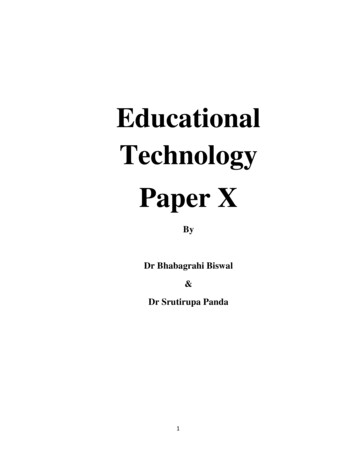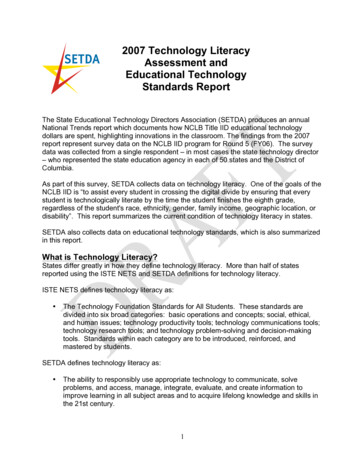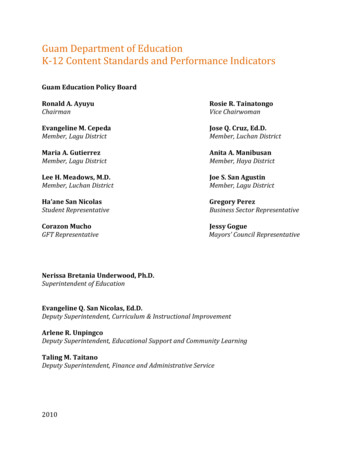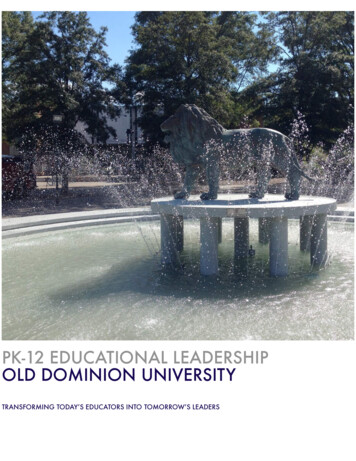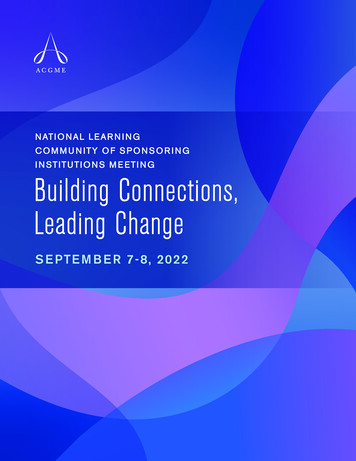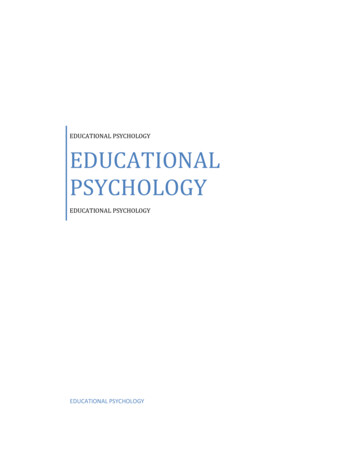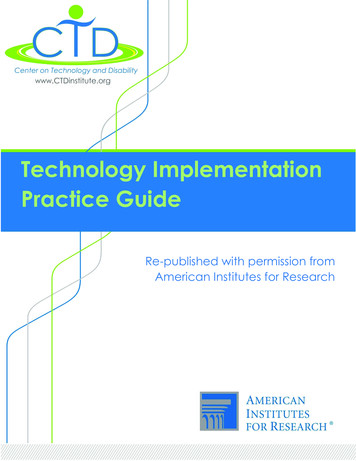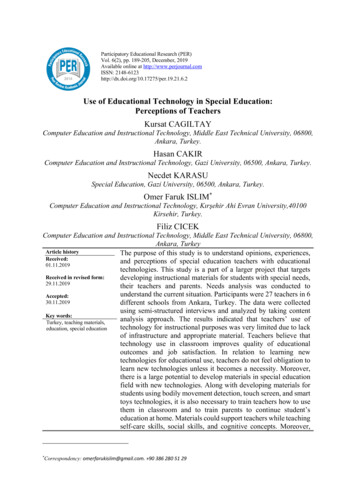
Transcription
Participatory Educational Research (PER)Vol. 6(2), pp. 189-205, December, 2019Available online at http://www.perjournal.comISSN: se of Educational Technology in Special Education:Perceptions of TeachersKursat CAGILTAYComputer Education and Instructional Technology, Middle East Technical University, 06800,Ankara, Turkey.Hasan CAKIRComputer Education and Instructional Technology, Gazi University, 06500, Ankara, Turkey.Necdet KARASUSpecial Education, Gazi University, 06500, Ankara, Turkey.Omer Faruk ISLIM*Computer Education and Instructional Technology, Kırşehir Ahi Evran University,40100Kirsehir, Turkey.Filiz CICEKComputer Education and Instructional Technology, Middle East Technical University, 06800,Ankara, TurkeyArticle historyThe purpose of this study is to understand opinions, experiences,Received:and perceptions of special education teachers with educational01.11.2019technologies. This study is a part of a larger project that targetsReceived in revised form:developing instructional materials for students with special needs,29.11.2019their teachers and parents. Needs analysis was conducted tounderstand the current situation. Participants were 27 teachers in 6Accepted:30.11.2019different schools from Ankara, Turkey. The data were collectedusing semi-structured interviews and analyzed by taking contentKey words:analysis approach. The results indicated that teachers’ use ofTurkey, teaching materials,technology for instructional purposes was very limited due to lackeducation, special educationof infrastructure and appropriate material. Teachers believe thattechnology use in classroom improves quality of educationaloutcomes and job satisfaction. In relation to learning newtechnologies for educational use, teachers do not feel obligation tolearn new technologies unless it becomes a necessity. Moreover,there is a large potential to develop materials in special educationfield with new technologies. Along with developing materials forstudents using bodily movement detection, touch screen, and smarttoys technologies, it is also necessary to train teachers how to usethem in classroom and to train parents to continue student’seducation at home. Materials could support teachers while teachingself-care skills, social skills, and cognitive concepts. Moreover,Correspondency: omerfarukislim@gmail.com. 90 386 280 51 29*
Use of Educational Technology in Special Education K. Cagiltay, H. Cakir, N. Karasu, O.F. Islim, F. Cicekthey help students to reinforce and transfer these skills andknowledge to new contexts by providing many practice-feedbackand variety of real contexts.IntroductionWith the development of computers, technology in education has dramatically changedand variety of opportunities emerged to support teaching and learning processes. As processingand storage capacity of computers improved, their role of supporting teaching and learning hasevolved. Utilizing computers to deliver the instructional content with supportive multimediaelements such as interactive images, videos, animations, simulations, and computer gamesmade computers as standalone supporter of students and teachers ( Hew & Cheung, 2010;Means, Toyama, Murphy, Bakia, & Jones, 2009; Ma & Nickerson, 2006; Penuel, 2006; Rutten,van Joolingen, & van der Veen, 2012). Continuous developments in the information andcommunication technologies (ICT) had its share in the instructional technologies as well. Whilenowadays much of the research focuses on instructional technologies to be utilized to improveactive learning and interactions among teachers and students in regular learning environments,teachers and students from special education group have not much benefited from thesedevelopments. Many of the technologies in the special education field were called as assistivetechnologies (Edyburn, 2013; Okolo & Bouck, 2007). The Assistive Technology Act (2004),which was signed by the US Government in October 25, 2004, defines assistive technology as“Any item, piece of equipment or product system, whether acquired commercially off the shelf,modified, or customized, that is used to increase, maintain, or improve functional capabilitiesof individuals with disabilities”. The assistive technology is an umbrella term that coverswalkers, wheelchairs, hardware, software and any kind of equipment that helps and ease thelife of people with disabilities. These technologies give chance disabled people to haveindependent life and involve in the society (World Health Organization, 2012)Current technology holds great potential for teaching and learning activities in special educationarea. Alternative ways of interaction with computers, fast-responding processors, highdefinition animated graphics, and communication/collaboration over the internet facilitatebetter learning environments for students, teachers, and parents. Game consoles such asNintendo’s Wii and Microsoft’s Xbox and tablets provide different modes of interaction withcomputers than traditional mouse-keyboard model. In traditional model, the user givescommands to computers by using keyboard and mouse, however, using keyboard and mouserequires hand and eye coordination to be used effectively (Laursen, Jensen, Garde & Jargensen,2002), for which not all special education students may have such skills (Shimizu, Yoon, andMcDonough, 2010). Instead of using mouse and keyboard, using body gestures or touch screensto interact with computers provides better interaction and user experience results (Findlater,Froehlich, Fattal, Wobbrock & Dastyar, 2013; Lee, Isenberg, Riche & Carpendale, 2012;Wachs, Kölsch, Stern & Edan, 2011).Students with special learning needs or students with developmental disabilities can beconsidered as a type of students with low academic ability students. Some of the general learnercharacteristics include short attention span, low capacity of working memory, need forrepetitious practice and feedback sessions, and difficulties to make connections between eventsand characters in the same story (Bender, 2008; Taylor, Richards, & Brady, 2005; Wenar &Kerig, 2006). Typical instruction for these students is highly structured, provides strictguidelines, progresses with small steps, repeats practices and feedback sessions as many timesas students need (Kirk, Gallagher, Coleman, & Anastasiow, 2011; Smith, Polloway, Patton, &Participatory Educational Research (PER)-190-
Participatory Educational Research (PER), 6 (2);189-205, 1 December 2019Dowdy, 1990). This type of instruction can be developed with educational technology toolssuch as computers, tablets, or game consoles. Research shows that special education studentsbenefit from educational technology, especially in concept teaching and in practice-feedbacktype instructional activities (Carter & Center, 2005; Hall, Hughes, & Filbert, 2000; Hasselbring& Glaser, 2000). Generally, video based, or keyboard-mouse interaction type computer-basedtechnologies have been utilized in special education cases, which have very limited studentinteraction and feedback capacities. However, computer technologies that allow students tointeract via alternative channels such as body gestures or touch screens have potential toproduce better learning results for students (Hwang, Wu & Fan-Ray, 2013).Although technology in education brings out certain positive results in terms of educationaloutcomes, teachers play a key role to facilitate the diffusion and the use of educationaltechnology (Brinkerhoff, 2006; Inan & Lowther, 2010; Zhao & Frank, 2003). Much of thetechnology with instructional purposes in schools are used by teachers. Whether it is for thepurposes of presentation, record keeping, communication, or information search, members ofthe teacher body in an educational institution are the primary users of the technology in theirclassrooms (Bebell, Russell, & O’Dwyer, 2004; Hernandez-Ramos, 2005; Persichitte, Tharp,& Caffarella, 1997; Smerdon et. al., 2000).There are certain factors that affect instructors' use of technology in teaching process. Ertmer(1999) classified these factors into two groups as internal and external factors. Internal factorswere identified as teachers' attitudes, motivation and competency towards using technology inthe classroom and external factors were identified as curriculum, technical infrastructure,training, and school culture. Literature has large number of studies that investigated thesefactors on variety of teaching subjects (Abbitt, 2011; Bingimlas, 2009; Ertmer, 2005; Higgins& Spitulnik, 2008; Mumtaz, 2000; Niess, 2005; Polly, Mims, Shepherd, & Inan, 2010),however most of them are focused on mathematics, science, and elementary education. Specialeducation and teachers in special education field have been generally ignored or studied verylittle in technology integration studies (Edyburn, 2001; Smith & Okolo, 2010; Twyman &Tindal, 2006). There is especially a knowledge gap in the literature about thoughts of specialeducation teachers’ attitudes and opinions about using technology for students with speciallearning needs, especially computer-based materials that support alternative ways to interactwith computers.Significance of the studyThere is a growing interest towards developing computer-based instructional materialsfor students with special learning needs in educational research community yet ourknowledgebase about how special education teachers integrate the computer technologies inspecial education classrooms is very limited (Seo & Bryant, 2009; Stetter & Hughes, 2010).Before designing any sorts of instruction, instructional designers must have good understandingof needs and capabilities of potential users of the instructional materials (Morrison, Ross,Kemp, & Kalman, 2010). It is especially more important in special education context in whichteachers' needs, attitudes, competencies, and utilization of instructional technologies in theirclassrooms have been largely ignored in terms of designing computer supported instructionalmaterial.The purpose of this study is to understand needs and attitudes of special education teacherstowards computer based instructional materials. The findings of this study have potential toshed light on design and development of computer based instructional materials thatParticipatory Educational Research (PER)-191-
Use of Educational Technology in Special Education K. Cagiltay, H. Cakir, N. Karasu, O.F. Islim, F. Cicekspecifically meet needs of students with special learning needs and their teachers.MethodContextThe study is an educational technology usage project that targets students with speciallearning needs, their teachers and their parents. The purpose of the project is to develop threemajor educational technologies that help all three parties to improve teaching and learningexperiences in school and at home. The first products involve computer games that can becontrolled by bodily movements, it aims to teach and practice kinaesthetic and self-care skillsto students. The second products involve tablet and interactive table that enable students tolearn and practice matching, numbers, letters, colours, and such concepts. The third productsinvolve smart toys that help students to learn and practice storytelling and communication skillsusing conventional computers. The products of the project aim to help students, their teachers,and their parents in two dimensions. First, the products can be used in schools to help studentsand teachers to engage with educationally meaningful activities to learn concepts and skills.Second, as special education needs to be continued at home under parents’ supervision, thesetechnologies are hoped to help the students and their parents to practice at home for what theylearned in school. Hence, parents can support work in school by practicing concepts and skillsat home.In the context of this study, developed educational technology materials are to be mainlyutilized by teachers in special education classes. Therefore, it is important to understand theircompetency levels of technology use and their attitudes towards technology use in theirclassrooms with the target group. Another part of the study’s context is special educationschools in Turkey. These schools focus on students with special learning needs with eightstudents and individual study classrooms. The curriculum and teaching materials are providedby Ministry of National Education and teachers apply pre-set goals and objectives by thecurriculum in these schools. Each student has a learning goals agenda to accomplish during theschool year. Depending on the students’ learning ability level, they can be put in an 8-studentclassroom or they work with teachers individually. In order to provide equal access toeducational opportunities, the schools targeted students with special learning needs wereopened nearly all large and small cities. The schools that were cooperated with this researchproject located in a highly populated urban area. Like all other schools, these schools were alsoequipped with computer labs, internet connections, smart boards, and projectors that weresupplied by the Ministry of National Education or bought by parent unions.Research MethodologyThe main purpose of this qualitative study is to understand perception of specialeducation teachers towards use of technology in their classes and how they use technology intheir classes. The qualitative studies aim at in depth analyzing and defining a case (Fraenkel,Wallen, & Hyun, 2012; Yin, 2011) that reflects the views and opinions of participants (Yin,2011). In this manner, a need analysis was conducted which provides information about currentand desired state of the situation or phenomenon under investigation based on participants’opinions. Main data collection method was semi-structured interviews with special educationteachers and administrators in schools. Collected data were transcribed and coded with utilizingconstant comparative approach of qualitative data.Participatory Educational Research (PER)-192-
Participatory Educational Research (PER), 6 (2);189-205, 1 December 2019ParticipantsParticipants of the study were special education teachers and administrators who workin urban schools that serve students with special needs. Since schools that serve and teachersthat teach students with special needs are rare in comparison to other public schools, theresearch team took referral sampling approach to identify teachers to interview. For this study,research team visited the participating schools and gave a brief presentation about educationaltechnology in special education and details about the aforementioned educational technologyproject. The project team also mentioned the need for interviewing teachers to understandcurrent and desired classroom technologies, teachers’ abilities for, and attitudes towards use oftechnology in their teaching process. Volunteered teachers were signed up for the interviewsand they were asked whether they can refer any other teachers who use technology in theirclassrooms.22 teachers and five administrators were interviewed in six schools. Among these schools, twoschools were funded and operated by the Ministry of National Education and rest of the schoolswere funded by the Ministry of National Education but operated by private enterprises. Allschools were located in urban region of the city. 22 participants were female and rest of themwere male.The composition of participated teachers shows a great variation in terms of major and teachingexperience. In Turkish Universities, schools of education with special education departmentsare limited in numbers, not all interviewed teachers held a major degree in special education.In order to teach in special education classes, teachers with elementary education or earlychildhood education majors were trained in certificate programs and assigned as specialeducation teachers in these schools. Among the interviewed teachers, seven teachers helddegree from special education major in undergraduate education and rest of the teachers held acertificate degree of special education.Teaching experiences of interviewed teachers are also varied in terms of teaching subject andyear of teaching experience in special education. Since some of the teachers started theirteaching career as elementary or early childhood teachers, their teaching experience consists ofspecial education or other education. Among the interviewed teachers, seven of them fullyspecial education teaching experiences in their career and it was approximately 11 years inaverage. Other teachers had approximately five years of special education teaching experienceapart from their elementary or early childhood education teaching experiences. This was anexpected situation in Turkish special education context since departments that specialized ononly special education in school of educations are not widespread, and the number of graduatesis not sufficient to fill all the positions in special education schools. Therefore, Ministry ofNational Education grants early childhood education or elementary education teachers withspecial education degrees after completing a certificate program. Some participants in this studystarted teaching special education schools after teaching in elementary education schools.Prior to interview questions related to use of technology in classrooms, the research team askedteachers about how competent they felt about certain computer use skills such as operating acomputer, using word processors, presentation software, surfing and searching on the Internet,adding or removing hardware, and diagnosing a technical problem on computers. Majority ofparticipants are comfortable with many of these skills except adding and removing hardwarepieces and diagnosing a technical difficulty on computers. The main reason for that situationcould be as the years of teaching experience indicates, all teachers are coming from a generationthat is already familiar or utilizes information and communication technologies in their dailyParticipatory Educational Research (PER)-193-
Use of Educational Technology in Special Education K. Cagiltay, H. Cakir, N. Karasu, O.F. Islim, F. Ciceklives.Data CollectionIn order to collect data from teachers, semi-structured interviews were conducted. Aninterview form was developed to guide the interview and help the participants stay focused ontechnology use in special education.The interview protocol was developed by the research team and went through severalimprovement steps to assure the reliability, validity, and understandability of the questions. Asa first step, the research team developed interview questions based on needs analysis studiesthat took place in the literature and from researchers’ previous experiences. Then thesequestions were discussed with experts from special education and educational technologyfields. Based on the recommendations from the experts, the interview questions were grouped,and small changes were made. Then a pilot interview took place with a special education teacherto test the interview protocol in terms of readability of the informed consent form, clarity of thequestions, and length of the interview. After finalizing the interview protocol, researchpermission was obtained from the ministry of national education. Interviews were conductedby a 4-person research team. Before starting the interviews, the research team was trained abouthow to start, continue, conclude, and summarize the data obtained from the interview. Allinterviewers had the same procedure to apply during the interview process, which contributesto ensure the reliability of the data collection.In average, interviews lasted approximately 40 minutes per participant. All interviews weretape recorded after informing the participants and obtaining their consent to do so. After eachinterview, interviewer summarized thoughts and reflections related to the information obtainedfrom the participant. All interviews were transcribed by the research team to do contentanalysis.Data AnalysisThe main data analysis method was to content analysis of the data. Content analysis isa qualitative data analysis method that helps researchers to understand major thoughts andconnections between them within a given data set. It starts with determining free thoughts, orcommonly called codes, within the data set and continues to group and connect these codesmeaningfully to plot the meaning behind the data. According to Creswell (2007), coding is thehearth of qualitative data analysis. Coding is separating raw text into small meaningful chunkswhile keeping the relationship between them. The main aim of coding is to analyze,differentiate and compare the data (Miles & Huberman, 1994). Researchers may utilizedifferent coding strategies: creating a brand-new coding table or using a pre-determined codingtable from the literature (Creswell, 2007, 2009; Miles & Huberman, 1994).In order to analyze the data, the research team transcribed all interviews into separate file foreach participant. After reading all data, a meeting was held to generate common understandingwithin the researchers. This is an important step since an analyzer generates codes and assignsthem certain meaning, which later may affect consistency amongst the coders. After generatingthe codes an analyzer and an expert worked together to discuss the meaning of codes and toplace these codes under larger categories.Since a researcher can be both an interviewer and an analyzer, it is a challenge to ensureobjectivity in any given qualitative research project. One of the difficulties related to contentParticipatory Educational Research (PER)-194-
Participatory Educational Research (PER), 6 (2);189-205, 1 December 2019analysis of qualitative data is to ensure reliability and validity of the data analysis process. Inorder to assure consistency among analyzers, regular group meetings were held to discuss themeaning of the data and the codes generated. Finally, part of the data was coded by two codersto understand the consistency between coders. It was calculated that two coders were consistentat 80% to assign thoughts to codes in the data set.FindingsResults of the analysis showed that thoughts in the interview data collected from specialeducation teachers can be grouped in four main categories. They can be listed from the mostmentioned to least mentioned as (1) Teachers’ technology use, (2) Necessary technologies andmaterials, (3) Effect of technology on educational outcomes, and (4) Teachers’ attitudestowards technology.Table 1. Distribution of codes among participantsCategory – CodeNumberParticipantsof NumberideasofTeachers’ Technology UseCurrent technologies1630Using technology in schools1223Monitoring student performance1420Difficulties with technology1320Internet resources1114Technologies that can be developed1333Areas to develop technological materials1117Generalization and transfer1117Group training1216Motivation1516Job satisfaction1113Interest to use technology1522Perceptions of technology competencies1820Interest to learn new technologies710Necessary Technologies and MaterialsEffect of Technology on Educational OutcomesTeachers’ Attitudes towards Technology“Teachers’ technology use” category gathers the ideas from the data about what kind oftechnologies and how special education teachers use them in their teaching activities. Fivecodes related to teachers’ technology use were grouped under this category, all of which helpus to understand teachers’ experiences with technology use. The second major category,“Necessary technologies and materials”, gathers codes for technologies and materials that areneeded in teaching special education students. Generally, teachers stated their thoughts aboutwhat materials and technologies can be used to teach certain concepts and skills. The thirdmajor category, “Effects of educational technology on educational outcomes, contains codesParticipatory Educational Research (PER)-195-
Use of Educational Technology in Special Education K. Cagiltay, H. Cakir, N. Karasu, O.F. Islim, F. Cicekrelated to how use of educational technology affects students’ educational outcomes such asengagement, learning, generalization, and transfer of newly introduced knowledge and skills.Finally, the fourth major category, “Teachers’ attitudes towards technology”, includes codesrelated to interviewed teachers' attitude and motivation towards use of computer technologiesin their daily life and in classroom for teaching and learning activities. Following sectionexplains the major categories and codes nested under them in detail.Teachers’ Technology UseUnder this category, codes that are related to current technologies that teachers use intheir daily life and classroom are explained. All teachers mentioned they are familiar withcontemporary technologies. By contemporary technologies, they mean desktop, laptop, andtablet computers, the Internet, smartboards, projectors, and cell phones. In addition to that thesetechnologies are available to teachers at schools to use them in their classrooms, teachers usethem, especially computers, internet, and cell phones, at their home too. This part of the datashows that teachers have required hardware, infrastructure, and knowledge to use thetechnologies.The second most mentioned thought was monitoring student performance with technology. Inspecial education classes, it might be highly beneficial monitoring and documenting studentperformance within certain time intervals. Teachers use technology in monitoring studentperformance during the performance monitoring activity, student videos are recorded, thenteacher fills a behavior checklist. These checklists are prepared in computers and teacherscomplete them either using their laptop or desktop computers. Although teachers mentionedabout recording students’ video to understand the student’s progress on learning concepts orskills between measurement points, they usually do it with observations rather than videorecording.The third code is related to how teachers use and would like to use technology in their schoolsand classrooms. Teachers stated that they usually use desktop or laptop computers for personaltasks, getting print outs, and rewarding students with computer games. They also use smartboards for teaching and practicing concepts. They use technology for rewarding students aftersuccessfully completed learning tasks or giving feedback on their learning process. This isstated in a teacher’s comment related to using smartboard to tell a story about a concept andthen allowing students to answer questions related to newly learned concept while the computerprovides feedback to students.".we were listening to the story. At the end of the story were questions related to it. Theywere answering these questions by touching. For example, let's say blue car. With whomdid the blue car meet? answer was yellow car, then they were touching yellow car. Or apage was opening, show the land vehicles. When they touched a correct vehicle, anapplause sound was started. When they touched an incorrect vehicle a sulky voice like"yaa" was heard. They loved this activity".The fourth code under this category is related to teachers’ experienced difficulties with usingtechnology in their classrooms. When it comes to difficulties to use technology in classrooms,teachers stated two major obstacles, first, financial difficulties to obtain and maintain thetechnology and, second, lack of materials that are usable in special education classes.Additionally, few teachers mentioned about lack of training to use technological tools in theclassroom. Obtaining and maintaining technology for schools is a financial issue and schoolslargely depend on funds from government to operate and pay teachers’ salaries. Therefore,Participatory Educational Research (PER)-196-
Participatory Educational Research (PER), 6 (2);189-205, 1 December 2019neither many funds are allocated to equip the classrooms with technology nor do teachers havesufficient salary to obtain technology with their own funding. A teacher states that "First of allthey need to have the financial power to obtain these devices. It is not easy for teachers to obtain themconsidering teachers' salary situations" to sum up the situation. The second major issue with thetechnological difficulties is lack of educational materials that are developed for audience inspecial education. Teachers stated that they can find the materials on the Internet or from othersources, but they have to make certain modifications or use limited parts of the materials, whichis not compatible with the special education curriculum. A teacher stated that".there is lack of technological materials that are useful for us, I think this is the biggestbarrier. The materials we found on the internet were developed for normal children, I meanthe kids with normal intelligence levels. I cannot find materials for students with learningdisabilities".Another teacher supported this opinion with stating;".in terms of content, I mean we don't have very well-developed contents that are relatedto the special education. Our software was good but in very very limited field, they neededto be improved. It is controversial claim that the material we have is appropriate for specialeducation. Before we use them, we need to make some simple changes or pause them whilepresenting to the students. Colors, brightness or other features of the material sometimesare not appropriate, I mean the kids cannot see easily"The fifth code is related to the internet resources that teachers find useful or benefit from. Allteachers are competent to use computers with the Internet connection in order to find teachingresources for themselves and for their students. However, these resources are not sufficient forspecial education teachers. The materials are usually developed for early chi
however most of them are focused on mathematics, science, and elementary education. Special education and teachers in special education field have been generally ignored or studied very little in technology integration studies (Edyburn, 2001; Smith & Okolo, 2010; Twyman & Tindal, 2006).


